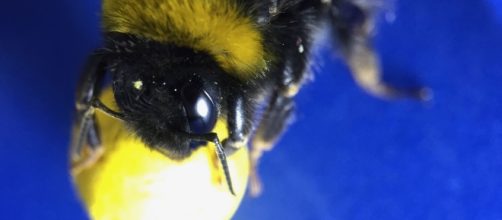bees have learned to roll a ball and take it to a specific point - scoring a goal - by observing each other, new research has revealed. Scientists used bumble bees to conduct the experiment. The study concluded that these insects are smarter in solving problems than previously thought. This is because, previous surveys of mammals found that they could perform complex tasks, but all were associated with the animal's natural behavior, such as manipulating different parts of a flower to gain access to the nectar.
First part of the study
In the first part of the study, published by the scientific journal Science, a platform, a yellow ball and a goal - a target containing a sucrose reservoir (table sugar) were used.
The scientists then 'taught' a group of bees how to roll a ball to get to the particular spot where they could win the reward. This was made by a fake bee stuck on a stick.
They observed that bees that did not receive instructions failed to complete the task. The researchers also found that those that were taught improved their performance throughout the tests. At each experiment, the insects took less time and traveled a smaller path to reach the goal - the sugar reservoir.
The second part
The second part of the study involved a platform with three balls at varying distances from the center. In that case, scientists exposed the bees to three distinct scenarios: a 'fake' bee that moved the ball farther to the center, a 'hidden' magnet that moved the ball to the center or no training, and only a ball located in the center of the platform.
Then they checked that the bees could move one of the three balls to the center to receive a drop of the sugar solution. The results showed that bees performed twice as well when trained by other bees in comparison with the magnet. They also showed that their performance was better in the first two scenarios than when they did not receive any training.
Bees adapted the cognitive processing strategies
The success rates of taking one of the three balls to the center were 99%, 78%, and 34%, respectively. Surprisingly, however, bees generally chose to move the ball closer to the center - different from what they had been taught, a result that was repeated even when the ball was black rather than yellow.
According to the scientists, the experiments found that the bees showed a "very impressive portion of cognitive flexibility."

